This post may contain affiliate links. As an Amazon Associate I earn from qualifying purchases. If you click and buy, I may receive a small commission at no extra cost to you. Read our Disclosure Policy
If you are struggling to cope with negative emotions find out how expressive writing for emotional pain can help you to achieve a sense of balance.

How to Use Expressive Writing for Emotional Pain to Balance Your Emotions

You are well aware of the power of your emotions.
You probably also understand how sometimes they can seem out of control and unmanageable.
If you’d like to feel more emotionally balanced you might want to try an expressive writing for emotional pain exercise to work through your feelings in a safe space.
Research has shown that writing about emotions may help to ease stress.
Working through the following steps in your mental health journal will help you to better understand the emotion you were feeling and make positive changes in your life to help you handle them.

Defining your emotion
You need to be able to define the emotion in your own terms and from your own understanding.
Putting some distance between you and your emotion
It is important to gain some distance from your emotional pain.
This will help you gain clearer understanding of your feelings and how they are impacting you.
When you are in the middle of the situation dealing with the emotions in the here and now everything will seem muddled and you will struggle to see what is happening as well as the bigger picture.
Being able to release the negative emotions
By understanding and recognising the emotion as well as achieving distance you will be able to begin releasing the negativity surrounding it.
Gaining clarity
By focusing on the emotions and the associated triggers, feelings and behaviors you can gain clarity and start to make positive changes in your life.
Regrouping your feelings
By following through the previous skills you will be able to regroup your thoughts, feelings and attitudes.
You can then create a new set of behaviors for dealing with difficult situations that will help you to cope in the future.
Maintaining your new habit
As with all habits practice makes perfect and you will need to constantly remind yourself of the positive changes you have made with regards to your emotions and their impact on your life.
What will you do to remind yourself how to remain positive, calm and balanced?
Expressive writing can help you to achieve emotional balance as it will take you through all the skills above.
How Does it Work in Practice?
If you are suffering from an emotion such as anger then everything you think, feel and do will be tainted by it.
It will have a negative effect on you and your actions. And no one wants to live in a state of anger for long.
By working through an expressive journaling session you can write yourself into a more emotionally balanced state.
Practice with a positive memory first

Now this process will take some practice so it’s actually easier to start with a positive emotion and work through the steps.
Think about a really happy memory of a time when you were not experiencing any anger or any other negative emotions. Your gratitude journal is a great place to look for one.
Write down how you felt and why you felt so positive and happy.
You will want to make your writing really descriptive so that you can see the scene clearly in your mind. Make it colorful, add details of the sounds, smells and things you could touch and even taste.
As you are writing ask yourself the following questions to help you dig deep into the memory and the emotion.
- When?
- Where?
- What?
- Who?
- How?
- Why?
This positive memory will become an anchor for you.
You can display it somewhere prominent or keep it safely hidden for use when needed.
When you are feeling anxious, stressed, sorrowful, angry or any other negative emotion you can look back over what you have written.
And if you have a bad day you can refer to it and be reminded of a happier positive time.
Now you can try to write through a negative emotion

Once you have practiced writing about a really positive emotion you can turn your thoughts to a negative one.
Again you might want to practice writing about a negative emotion while you are in an emotionally stable mood, so you can work through the steps.
Be sure to really drill down and write about the event and your emotions.
Work through the when, where, what, who, how and why prompts as this will really help you understand the emotion as well as any triggers and resulting behaviors.
By writing your thoughts and feelings at each stage, as well as identifying the triggers, you can not only understand the emotion better but also understand yourself and your reaction to it.
These expressive writing for emotional pain entries in your journal will give you a powerful tool to help you to take control of your emotions and achieve balance.
You will be able to refer to the entries to remind yourself how to cope with difficult situations or simply to see just how much you’ve achieved and grown over time.







